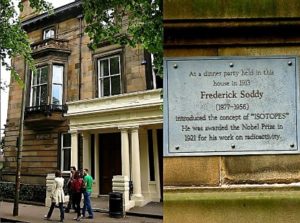Frederick Soddy, polymath and economic reformer
Editor

Extracted from the Wikipedia entry on Frederick Soddy:
Frederick Soddy (2 September 1877 – 22 September 1956) was an English radiochemist [FRS and Nobel laureate] who explained, with Ernest Rutherford, that radioactivity is due to the transmutation of elements, now known to involve nuclear reactions. He also proved the existence of isotopes of certain radioactive elements. He was a polymath who mastered chemistry, nuclear physics, statistical mechanics, finance and economics.
In four books written from 1921 to 1934, Soddy carried on a “campaign for a radical restructuring of global monetary relationships”, offering a perspective on economics rooted in physics – the laws of thermodynamics, in particular – and was “roundly dismissed as a crank”. While most of his proposals – “to abandon the gold standard, let international exchange rates float, use federal surpluses and deficits as macroeconomic policy tools that could counter cyclical trends, and establish bureaus of economic statistics (including a consumer price index) in order to facilitate this effort” – are now conventional practice [1], his critique of fractional-reserve banking [during his time] “remains outside the bounds of conventional wisdom” although a more recent paper by the IMF reinvigorated his proposals [2]. Soddy wrote that financial debts grew exponentially at compound interest but the real economy was based on exhaustible stocks of fossil fuels. Energy obtained from the fossil fuels could not be used again. This criticism of economic growth is echoed by his intellectual heirs in the now emergent field of ecological economics.
The New Palgrave Dictionary of Economics, an influential reference text in economics, recognized Soddy as an economic reformer [3].
References:
- Zencey, Eric (12 April 2009). “Mr. Soddy’s Ecological Economy”(Opinion). The New York Times. Retrieved 22 December 2017.
- Beneš, Jaromír; Kumhof, Michael (August 2012). “The Chicago Plan Revisited”. SSRN2169748.
- Macmillan Publishers Ltd, ed. (2018). The New Palgrave Dictionary of Economics. London: Palgrave Macmillan UK. doi:10.1057/978-1-349-95189-5. ISBN978-1-349-95188-8.





























